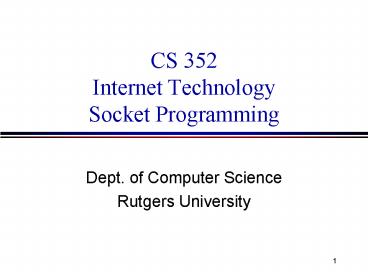CS 352 Internet Technology Socket Programming - PowerPoint PPT Presentation
1 / 23
Title:
CS 352 Internet Technology Socket Programming
Description:
Server is passive, waits for connections. Client initiates the connections ... wait on accept() method for a new client. accept() returns a new socket ... – PowerPoint PPT presentation
Number of Views:55
Avg rating:3.0/5.0
Title: CS 352 Internet Technology Socket Programming
1
CS 352Internet TechnologySocket Programming
- Dept. of Computer Science
- Rutgers University
2
Abstract Socket Service
- Asymmetric set-up, circuit abstraction
- Server is passive, waits for connections
- Client initiates the connections
- Bi-directional, continuous byte stream
- TCP is free to break up the data however it likes
- But often doesnt
- Tries really hard when packets are lost
- really best effort
- but timeouts on the order of 15 minutes
3
IP Layering Architecture
Host B
Application Protocol
Application Layer
Transport Protocols (UDP and TCP)
Transport Layer
IP
IP
IP
Network Layer
Network Layer
Network Layer
Host-to- Net Layer
Host-to- Net Layer
Host-to- Net Layer
4
Stream Service
- On the Internet, the Transmission Control
Protocol (TCP) implements a byte stream network
service
5
Internet Addressing
- Layer 3 addressing
- Each IP entity(E.g. host) has a 4-byte address
- As decimal A.B.C.D
- Can also be written as hexadecimal and binary!
- Domain Name System (DNS) translates symbolic
names to IP addresses - E.g. remus.rutgers.edu -gt 128.6.13.3
6
Ports
- Layer 4 addressing
- 2 byte port differentiates destinations within
an IP address - E.g. the mail server vs. the web server
- Fully qualified IP communication requires 5
tuples - Protocol ID (UDP, TCP)
- Source IP address, source port number
- Destination IP address, destination port number
7
Stream Sockets in Java
- InetAddress class
- Object for containing an using IP addresses
- methods for viewing and changing IP addresses and
symbolic names - InPutStream, OutPutStream classes
- get and receive bytes from a socket
- Socket and ServerSocket, classes
- A TCP communication objects
- Contain the stream objects once socket is
connected
8
Client-Server Connection Set-up
Client
Server
New server socket
create socket
accept()
blocked .
connection phase
blocked .
handshake
return.
New socket
data phase
Time
9
Read-Write, Teardown Phase
Client
Server
write()
read()
write()
read()
close()
close()
handshake
Time
10
Client Algorithm
- Create a socket object
- Set destination address and port number
- In constructor implies making a connection
- Get Input and Output Streams
- Call read(), write() and flush() methods
- Close() method when done
- Be nice to the system, port use
11
Client side
- String machineName
- int port
- Socket sock null
- InputStream in
- OutputStream out
- sock new Socket(machineName, port)
- in sock.getInputStream
- out sock.getOutPutStream
- bytesRead in.read(byteBuffer)
12
Server Algorithm
- Create a serverSocket on a port
- Loop
- wait on accept() method for a new client
- accept() returns a new socket
- get input and output streams for this sockets
- close the socket when done
13
Server Receive
- Socket nextClientSock
- while ( ... )
- nextClientSock ss.accept() // new socket
- // the return socket is bound and can
- // be used to send/receive data
- in nextClientSock.getInputStream
- out nextClientSock.getOutputStream
14
Server echo using execeptions
- try
- while( (bytesRead in.read(byteBuffer)) !
-1) - out.write(byteBuffer,0,bytesRead)
- out.flush()
- totalBytesMoved (long) bytesRead
- nextClientSock.close()
- catch (IOException e)
- System.out.println(Socket Error")
- nextClientSock.close()
15
Other useful methods
- inetAddress socket.getLocalAddress()
- get the machines local address
- socket.setSoTimeOut(int milliseconds)
- block only for int milliseconds before returning
- socket.toString
- get ip, port in a string
16
Important Points
- Work with bytes, not strings, if possible
- Conversions dont always work like you think
- Can use BufferedReader and writer around base
classes
17
Using Strings
- Strings must be converted to bytes
- Use wrappers around basic byte stream
- Example
- String InputLine
- out new PrintWriter(sock.getOutputStream(),true)
- in new BufferedReader( new InputStreamReader(
- sock.getInputStream()))
- InputLine in.readLine()
- out.println(InputLine)
18
Network Programming Threads
- Network code involves logical simultaneous
movement of data - Multiple levels of movement at once
- E.g. From the client to server and server to
client - E.g Between multiple clients and servers.
- Clients and servers must wait for events
19
Supporting Logical Channels
- Flow from client to server must operate
independently of flow from server to client - If read blocks, which to call first?
- What if read does not block?
20
Multiple Logical Channels
Thread
Server
Thread
- Need to support many channels at once
21
Concurrency in Java Threads
- Create a class that extends thread
- Must override the run method
- Instantiate an object of that class
- Invoking run method starts a new thread
- When caller returns, run method is still going!
- Calling join method waits for run to terminate
22
Threads in Java
- Class Channel extends Thread
- Channel(...) // constructor
- public void run()
- / Do work here /
- / other code to start thread /
- Channel C new Channel() // constructor
- C.start() // start new thread in run method
- C.join() // wait for Cs thread to finish.
23
Threads in Java
Time
Calling Thread
New object created
C new Channel()
Channel()
C.start()
New thread started
Run()
Work.
Work.
C.join()
Run() terminates
suspended































